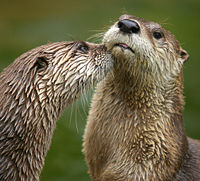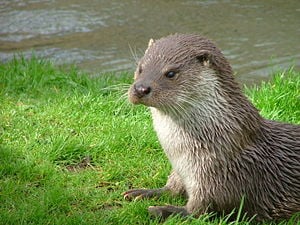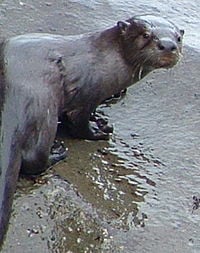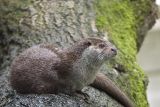Difference between revisions of "Otter" - New World Encyclopedia
(New page: {{Claimed}} {{otheruses1|the carnivorous mammal}} {{Taxobox | color = pink | name = Otters | image = LutraCanadensis fullres.jpg | image_width = 200px | image_caption = [[Northern River Ot...) |
({{Contracted}}) |
||
| Line 1: | Line 1: | ||
| − | {{Claimed}} | + | {{Claimed}}{{Contracted}} |
{{otheruses1|the carnivorous mammal}} | {{otheruses1|the carnivorous mammal}} | ||
{{Taxobox | {{Taxobox | ||
Revision as of 21:48, 19 July 2007
- This article is about the carnivorous mammal. For other uses of the term, see Otter (disambiguation).
| Otters | ||||||||||||
|---|---|---|---|---|---|---|---|---|---|---|---|---|
 North American River Otters
| ||||||||||||
| Scientific classification | ||||||||||||
| ||||||||||||
|
Amblonyx |
The otter (lutrinae) is a carnivorous aquatic or marine mammal part of the family Mustelidae, which also includes weasels, polecats, badgers, as well as others. With 13 species in 7 genera, otters have an almost worldwide distribution. The collective noun romp is used to refer to a group of otters.[1]
Physical characteristics
Otters have a dense layer (1,000 hairs/mm², 650,000 hairs per sq. in) of very soft underfur which, protected by their outer layer of long guard hairs, keeps them dry under water and traps a layer of air to keep them warm.
All otters have long, slim, streamlined bodies of extraordinary grace and flexibility, and short limbs; in most cases they have webbed paws. Most have sharp claws to grasp prey, but the short-clawed otter of southern Asia has only vestigial claws, and two closely-related species of African otter have no claws at all: these species live in the often muddy rivers of Africa and Asia and locate their prey by touch.
Diet
Otters do not depend on their specialized fur alone for survival in the cold waters where many live: they also have very high metabolic rates and burn up energy at a profligate pace: Eurasian otters, for example, must eat 15% of their body-weight a day; sea otters, 20 to 25%, depending on the temperature. In water as warm as 10°C an otter needs to catch 100 g of fish per hour: less than that and it cannot survive. Most species hunt for 3 to 5 hours a day; nursing mothers, up to 8 hours a day.
Most otters have fish as the primary item in their diet, supplemented by frogs, crayfish and crabs; some have become expert at opening shellfish, and others will take any available small mammals or birds. This prey-dependence leaves otters very vulnerable to prey depletion.
Species
Northern River Otter
The northern river otter (Lontra canadensis) became one of the major animals hunted and trapped for fur in North America after European contact. As one of the most playful, curious, and active species of otter, they have become a popular exhibit in zoos and aquaria, but unwelcome on agricultural land because they alter river banks for access, sliding, and defense. River otters eat a variety of fish and shellfish, as well as small land mammals and birds. They grow to 1 m (3 to 4 feet) in length and weigh from 5 to 15 kg (10 to 30 pounds).
Some jurisdictions have made otters a protected species in some areas, and some places have otter sanctuaries. These sanctuaries help ill and injured otters to recover.
Sea Otter
Sea otters (Enhydra lutris) live along the Pacific coast of North America. Their historic range included shallow waters of the Bering Strait and Kamchatka, and as far south as Japan. Sea otters have some 200,000 hairs per square cm of skin, a rich fur for which humans hunted them almost to extinction. By the time the 1911 Fur Seal Treaty gave them protection, so few sea otters remained that the fur trade had become unprofitable.
Sea otters eat shellfish and other invertebrates (especially clams, abalone, and sea urchins ), and one can frequently observe them using rocks as crude tools to smash open shells. They grow to 1 to 2 m (2.5 to 6 feet) in length and weigh 30 kg (25 to 60 pounds). Although once near extinction, they have begun to spread again, starting from the California coast.
Unlike most marine mammals (seals, for example, or whales), sea otters do not have a layer of insulating blubber. As with other species of otter, they rely on air-pockets trapped in their fur.
Maxwell's Otter
Zoologists believe that a sub-species of the Smooth-coated Otter, Lutrogale perspicillata maxwelli (named 'Maxwell's Otter' after the British naturalist Gavin Maxwell and the subject of his book Ring of Bright Water) lived in the Tigris-Euphrates alluvial salt marsh of Iraq. Some have suggested that this sub-species may have become extinct as a result of the large-scale drainage that has taken place in the region since the 1960s.
European Otter
Otters also inhabit Europe. In the United Kingdom they occurred commonly as recently as the 1950s, but have now become rare due to the former use of chlorinated hydrocarbon pesticides and as a result of habitat-loss. Population levels attained a low point in the 1980s, but with the aid of a number of initiatives, by 1999 estimated numbers indicated a recovery to under 1000 animals. The UK Biodiversity Action Plan envisages the re-introduction of otters by 2010 to all the UK rivers and coastal areas that they inhabited in 1960. Roadkill deaths have become one of the significant threats to the success of their re-introduction.
Giant Otter
The Giant Otter (Pteronura brasiliensis) inhabits South America, especially the Amazon river basin, but is becoming increasingly rare due to poaching, habitat loss, and the use of mercury and other toxins in illegal alluvial gold mining. This gregarious animal grows to a length of up to six feet / 1.83m.
Otters in mythology
The Old Icelandic word otr means "otter"; these and cognate words in other Indo-European languages ultimately stem from a root which also gave rise to the English words "water", "wet" and "winter". Norse mythology tells of the dwarf Ótr habitually taking the form of an otter. The myth of Otter's Ransom[2] is the starting point of the Volsunga saga.
In some Native American cultures, otters are considered totem animals. The time of year associated with this is also associated with the Aquarius sign of the Zodiac, through which the sun passes January 20-February 18.
Otters in literature
Non-fiction: Gavin Maxwell's stories of his life in a remote part of northern Scotland and of the otters he encountered there:
- Ring of Bright Water
- The Rocks Remain
Fiction:
- Otters appear very commonly in Brian Jacques's Redwall series.
- Henry Williamson's story Tarka the Otter
- Kenneth Grahame's The Wind in the Willows
- M. I. McAllister's The Mistmantle Chronicles
- Thornton Burgess's "Little Joe Otter"
- Seamus Heaney in his volume of poetry, Field Work, writes about otters in a poem of the same name.
- Otters were a frequent obsession of the surreal comedy Dare To Believe.
- Otter-like creatures called fenlings appear in David Eddings's series of books The Belgariad.
- An anthromorphic otter named Mudge is a reoccuring character in Alan Dean Foster's Spellsinger series.
- In the Harry Potter book series, Hermione Granger's patronus is an otter.
- In the Abhorsen series, Lirael uses an ice-otter charter skin.
Otters in popular culture
- The otter is the mascot for California State University Monterey Bay and the Orthodontic Technicians Association.
- The Erie Otters are an Ontario Hockey League Entry based in Erie, Pennsylvania. Their mascot is an Otter dressed as a hockey player called "Shooter".
- The Frontier League baseball team in Evansville Indiana is named the Evansville Otters. Their mascot is named "Evan The Otter".
List of species

Genus Lutra
- European Otter (Lutra lutra)
- Hairy-nosed Otter (Lutra sumatrana)
Genus Hydrictis
- Speckle-throated Otter (Hydrictis maculicollis)
Genus Lutrogale
- Smooth-coated Otter (Lutrogale perspicillata)
Genus Lontra
- Northern River Otter (Lontra canadensis)
- Southern River Otter (Lontra provocax)
- Long-tailed Otter (Lontra longicaudis)
- Marine Otter (Lontra felina)
Genus Pteronura
- Giant Otter (Pteronura brasiliensis)
Genus Aonyx
- African Clawless Otter (Aonyx capensis)
- Congo Clawless Otter (Aonyx congicus)
- Oriental Small-clawed Otter (Aonyx cinereus)
Genus Enhydra
- Sea Otter (Enhydra lutris)
Gallery
- Lontra canadensis.jpg
A North American river otter in Assateague National Wildlife Refuge
References and further reading
- ↑ (July/August 2004). Birds of a feather.... Natural History 113 (6): 71.
- ↑ The Otter's Ransom. Retrieved 2007-07-05.
- Galant, D., L. Vasseur, & C.H. Bérubé (2007). Unveiling the limitations of scat surveys to monitor social species: a case study on river otters. Journal of Wildlife Management 71:258–265.
External links
- The Somerset Otter Group
- The Otter Trust
- International Otter Survival Fund
- Otternet
- Otter - photos
- North American River Otter
Credits
New World Encyclopedia writers and editors rewrote and completed the Wikipedia article in accordance with New World Encyclopedia standards. This article abides by terms of the Creative Commons CC-by-sa 3.0 License (CC-by-sa), which may be used and disseminated with proper attribution. Credit is due under the terms of this license that can reference both the New World Encyclopedia contributors and the selfless volunteer contributors of the Wikimedia Foundation. To cite this article click here for a list of acceptable citing formats.The history of earlier contributions by wikipedians is accessible to researchers here:
The history of this article since it was imported to New World Encyclopedia:
Note: Some restrictions may apply to use of individual images which are separately licensed.





